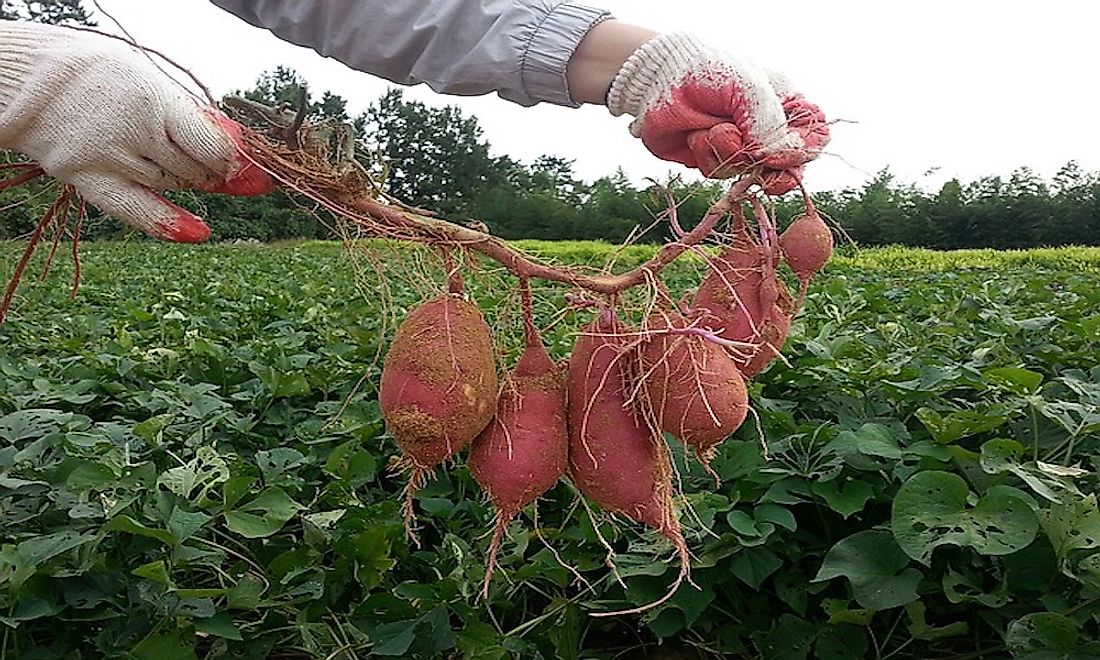World Leaders In Sweet Potato Production

The sweet potato (Ipomoea batatas), a root vegetable, is known for its starchy, large, tuberous roots that are consumed worldwide. The shoots and young leaves of the plant are also consumed in some parts of the world. Despite the name, it is distantly related to the common potato vegetable.
Description Of The Plant
The sweet potato plant is a perennial herbaceous vine with leaves arranged in an alternate manner. The sympetalous flowers are medium-sized and the leaves are heart-shaped. The tuberous roots are tapered and long and have a smooth skin. The plant, a native to the tropical regions of the New World, are available in many varieties.
Cultivation Of Sweet Potato
The sweet potato plant is unable to tolerate frost and grows best at an average temperature of 24 °C. Warm nights and abundant sunshine are ideal conditions for the growth of this crop. A minimum rainfall of 500 mm in the growing season is also required and the crop is highly sensitive to drought 50 to 60 days after planting. The tuberous roots mature in 2 to 9 months depending on a variety of factors. In areas with daylight less than 11 hours, sweet potato plants hardly flower. In such areas, vegetative propagation methods are followed instead. The plant requires well-drained soils with a pH range of 4.5-7.0 and light to medium texture for optimum growth. The plant is highly sensitive to aluminum toxicity.
Production Of Sweet Potato
The majority of the world production of sweet potato comes from China, the top producing country. More than half of the Chinese crop is utilized for livestock feed. In 2014, China produced 70,526,000 tons of sweet potato. The African nations of Nigeria and Tanzania rank next in sweet potato production, producing about 3,689,696 and 3,470,304 tons of the crop, respectively.
Uses Of Sweet Potato
Raw sweet potatoes are rich in simple starches and complex carbohydrates. The vegetables also have a rich content of beta-carotene, dietary fiber, manganese, vitamin B5 and vitamin B6, manganese, etc. Sweet potato cultivars that have a dark-orange flesh have a higher content of beta-carotene. Although the tuberous roots are the most common edible product, leaves and shoots are also eaten.
Sweet potatoes are utilized to prepare a wide variety of dishes in many countries across the world. For example, in West African countries, young leaves and vine tips are consumed as a vegetable. In Egypt, sweet potato tubers are a common winter street food and are baked at home to prepare desserts and snacks and served with honey. Roasted sweet potatoes are one of China’s popular street food. The vegetable also plays an important role in Japanese, Taiwanese, and Korean cuisine. In India, sweet potato is an important food consumed after religious fasting. In Canada, sweet potatoes are served as a side dish and are prepared with orange juice, maple syrup, or molasses. Sweet potato pie is popular in the US. Similarly, this vegetable is used to prepare a wide variety of delectable dishes in other parts of the world.
Sweet potatoes are also put to some non-culinary uses. In South America, the juice extracted from this vegetable is mixed with lime to prepare a textile dye. Sweet potato plant parts are used as animal feed. Since sweet potato rapidly forms roots in water and grows under good light conditions, the vine is used in home aquariums. Researchers are also experimenting on producing a root potato variety that will be used for biofuel production.
World Leaders In Sweet Potato Production
| Rank | Country | Sweet Potato Production in tons, 2013 |
|---|---|---|
| 1 | China | 70,526,000 |
| 2 | Nigeria | 3,689,696 |
| 3 | Tanzania | 3,470,304 |
| 4 | Indonesia | 2,386,729 |
| 5 | Uganda | 1,810,000 |
| 6 | Ethiopia | 1,782,725 |
| 7 | Mozambique | 1,468,575 |
| 8 | Vietnam | 1,358,175 |
| 9 | Angola | 1,199,749 |
| 10 | India | 1,132,400 |











